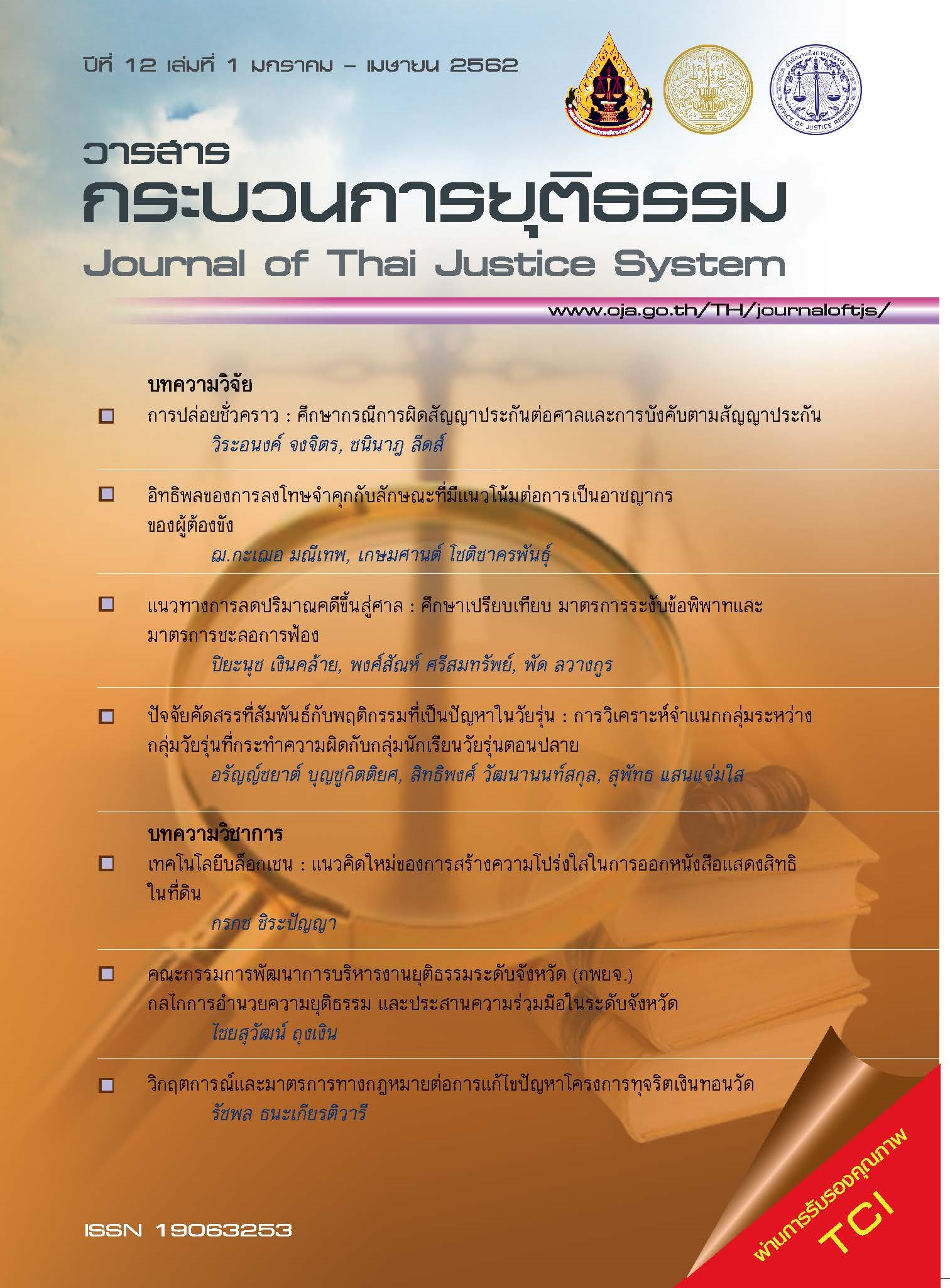อิทธิพลของการลงโทษจำคุกกับลักษณะที่มีแนวโน้มต่อการเป็นอาชญากรของผู้ต้องขัง
Main Article Content
บทคัดย่อ
การศึกษาเรื่องอิทธิพลจากการลงโทษจำคุกต่อลักษณะที่มีแนวโน้มต่อการเป็นอาชญากรของผู้ต้องขัง โดยมีวัตถุประสงค์ในการศึกษา 1) เพื่อศึกษาลักษณะที่มีแนวโน้มต่อการเป็นอาชญากรของผู้ต้องขัง 2) เพื่อศึกษาอิทธิพลของการถูกตีตราทางสังคมด้วยการลงโทษจำคุกต่อลักษณะที่มีแนวโน้มต่อการเป็นอาชญากรของผู้ต้องขัง และ 3) เพื่อศึกษาอิทธิพลร่วมระหว่างอายุและโปรแกรมแก้ไขฟื้นฟู กับลักษณะที่มีแนวโน้มต่อการเป็นอาชญากรของผู้ต้องขัง โดยการศึกษาจากเอกสารแนวคิดทฤษฎีที่เกี่ยวข้อง และการสำรวจโดยใช้แบบสอบถามจากผู้ต้องขังชายที่ต้องขังในคดีที่เกี่ยวข้องกับยาเสพติด จำนวน 444 คน
ผลการวิจัยสรุปว่า 1) ผู้ต้องขังส่วนใหญ่มีลักษณะที่มีแนวโน้มต่อการเป็นอาชญากรของผู้ต้องขังอยู่ในระดับน้อย เมื่อพิจารณาข้อมูลแต่ละด้าน พบว่าผู้ต้องขังมีลักษณะของการต่อต้านค่านิยมของสังคม(Anti - social Values) และการยึดตนเองเป็นศูนย์กลาง (Entitlement) อยู่ในระดับมาก ในขณะที่ลักษณะด้านการหาเหตุผลเข้าข้างตนเอง (Rationalization) และการมีความสามารถในการควบคุมตนเองต่ำ (Low Self - control)อยู่ในระดับน้อย และมีลักษณะด้านการขาดกระบวนการคิดวิเคราะห์อย่างเป็นระบบ (Cognitive Laziness) ในระดับน้อยที่สุด 2) จำนวนครั้งในการจำคุกและอายุของผู้ต้องขัง มีอิทธิพลต่อลักษณะที่มีแนวโน้มต่อการเป็นอาชญากรของผู้ต้องขัง โดยผู้ต้องขังที่มีจำนวนครั้งมากกว่าจะมีลักษณะที่มีแนวโน้มต่อการเป็นอาชญากรของผู้ต้องขังมากกว่า ซึ่งสะท้อนจำนวนครั้งในการมีพฤติกรรมเบี่ยงเบนของบุคคลนั้น ๆ ส่งผลให้เกิดการตีตราซ้ำจากสังคมและถูกปฏิเสธจากสังคม และผู้ต้องขังที่มีอายุที่น้อยกว่าจะมีระดับการตีตราตนเองเป็นอาชญากรมากกว่าผู้ต้องขังที่มีอายุมากกว่า เนื่องจากผู้ที่มีอายุมากกว่ามีความมั่นคงทางด้านอารมณ์ ความคิด ทำให้มีภูมิคุ้มกันปฏิกิริยาตอบโต้จากสังคมมากกว่าผู้ที่มีอายุน้อยกว่า 3) ไม่พบว่ามีอิทธิพลร่วมระหว่างอายุและโปรแกรมแก้ไขฟื้นฟูต่อลักษณะที่มีแนวโน้มต่อการเป็นอาชญากรของผู้ต้องขัง
Article Details
ต้นฉบับที่ได้รับการตีพิมพ์ในวารสาร เป็นลิขสิทธิ์ของวารสารกระบวนการยุติธรรม แต่ความคิดเห็นที่ปรากฏในเนื้อหาของบทความในวารสารกระบวนการยุติธรรม ถือเป็นความรับผิดชอบของผู้เขียนแต่เพียงผู้เดียว
เอกสารอ้างอิง
เสกสัณ เครือคำ. (2558). อาชญากรรม อาชญาวิทยา และงานยุติธรรมทางอาญา. นครปฐม: เพชรเกษม.
เสริน ปุณณะหิตานนท์. (2558). การกระทำผิดในสังคม: สังคมวิทยาอาชญากรรมและพฤติกรรมเบี่ยงเบน. กรุงเทพฯ: จุฬาลงกรณ์.
กฤตยา อาชวนิจกุล และกุลภา วจนสาระ. (2560). “เรือนจำสุขภาวะกับการเปลี่ยนผ่านกระบวนทัศน์”. ใน กฤตยา อาชวนิจกุล และกุลภา วจนสาระ (กองบรรณาธิการ), “การขับเคลื่อน ‘คุกไทย’ สู่ ‘เรือนจำสุขภาวะ’ (หน้า 17-55). กรุงเทพฯ: เดือนตุลา.
กิติพงษ์ กิตยารักษ์. (2545). กระบวนการยุติธรรมเชิงสมานฉันท์: ทางเลือกใหม่สำหรับกระบวนการยุติธรรมไทย. กรุงเทพฯ: สำนักงานกองทุนสนับสนุนการวิจัย.
จุฑารัตน์ เอื้ออำนวย และคณะ. (2553). รายงานวิจัยการพัฒนากรอบแนวทางการวิจัยชุดโครงการกระบวนการยุติธรรมทางเลือกในสังคมไทย. กรุงเทพฯ: สำนักกิจการยุติธรรม กระทรวงยุติธรรม.
ธานี วรภัทร์. (2557). หลักกฎหมายมาตรการบังคับทางอาญา. กรุงเทพ: วิญญูชน.
นัทธี จิตสว่าง. (2542). หลักทัณฑวิทยา. กรุงเทพฯ: กรมราชทัณฑ์.
ประธาน วัฒนวาณิชย์. (2546). ความรู้เบื้องต้นเกี่ยวกับอาชญาวิทยา. กรุงเทพฯ: ประกายพรึก.
พรชัย ขันตี, ธัชชัย ปิตะนีละบุตร, และอัศวิน งามวิไล. (2558). ทฤษฎีอาชญาวิทยา: หลักการ งานวิจัยและนโยบายประยุกต์. กรุงเทพฯ: ส.เจริญการพิมพ์.
พระราชบัญญัติราชทัณฑ์พุทธศักราช 2560. (2560). ราชกิจจานุเบกษา. 134(21ก), 10.
สุทธิพล ทวีชัยการ. (2548). ทางเลือกในการเผชิญกับปัญหาความขัดแย้งกรณีผู้มีส่วนได้เสียหลายฝ่าย: การเจรจาต่อรอง การไกล่เกลี่ย หรือกระบวนการผู้มีส่วนได้เสียหลายฝ่าย. วารสารกฎหมายธุรกิจบัณฑิตย์, 5(2), 32 - 41.
หนังสือต่างประเทศ
Chase, J (2016). 10 Common Traits of Career Criminals. Retrieved from https://authorjenniferchase.com/2016/10/07/10-common-traits-of-career-criminals.
Erikson, K. T. (1966). Wayward Puritans: A Study in the Sociology of Deviance. New York: Wiley.
Hagan, F. E. (2013). Introduction to Criminology: Theory, Methods, and Criminal Behavior. CA: Thousand Oaks, SAGE Publications.
Lemert, E. (1951). Social Pathology. New York: McGraw-Hill.
Tannenbaum, F. (1938). Crime and community. Boston: Ginn.


